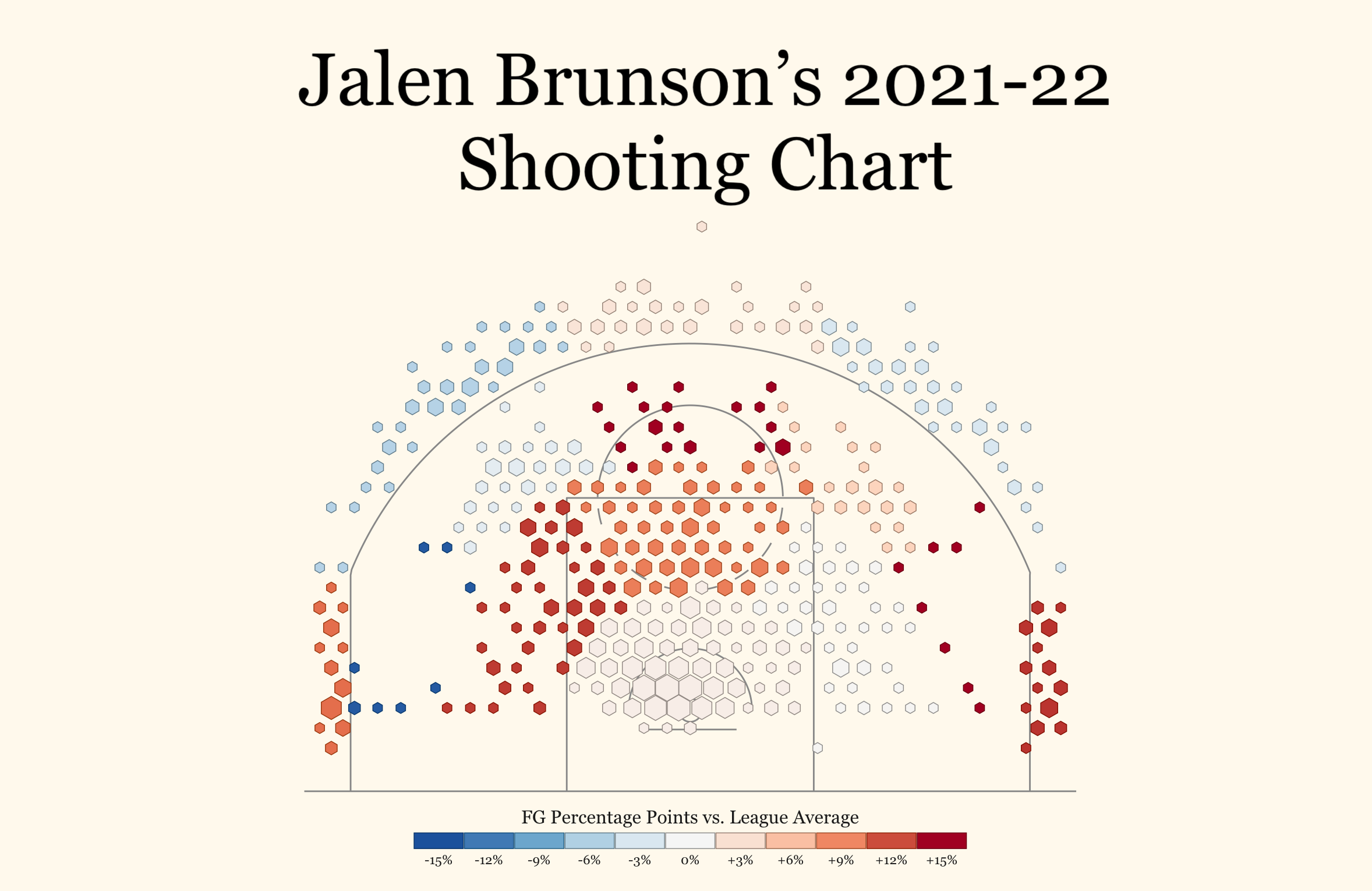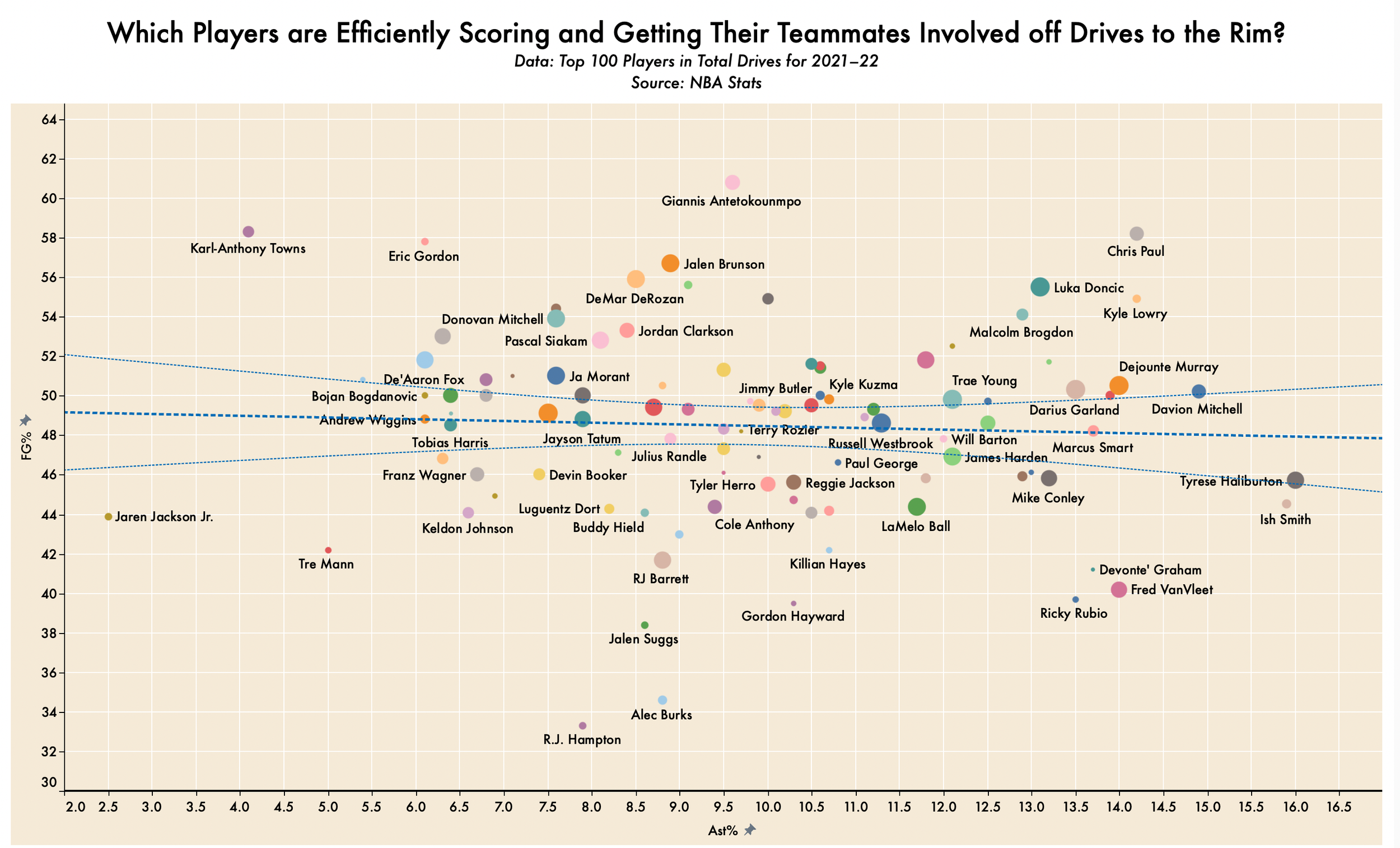Five Graphs: Gauging Jalen Brunson’s impact in 2021-22 as he heads to the Knicks
Jalen Brunson is a Knick, on a reported four-year, $104 million contract. So just how good of a player are the Knicks getting? Is Brunson prepared to make a leap? Drew Steele explores the data.
The Knickerbockers of New York finally got their point guard, baby! What’s his name?
JA-LEN BRUN-SON (clap — clap — clap clap clap)!
I gotta say, witnessing the Knicks screw over the Dallas Mavericks once again by signing their second-best player who unequivocally fits next to Luka Doncic because Mark Cuban lost money in cryptocurrency was as beautiful as a scene shot by Sir Roger Deakins. And the cherry on top of this free agency sundae was that Brunson signed a deal that was less than the projected four-year, $110 million contract he was initially reported to have signed. Such a masterclass play by The Don himself, Leon Rose.
We already know who Jalen Brunson is as a person. It’s been discussed ad nauseum on Internet forums, Twitter, ESPN, and wherever you can get sports content. We know his connections to the individuals working for the Knicks. But who exactly is Jalen Brunson as a player? I’m assuming someone else on The Strick dot land will dive into film on Brunson. Maybe someone did already by the time you’re reading this article. Maybe that person will be me at an undisclosed date in the offseason. I have no clue. The clue that I do have, however, is one related to the numbers.
I present to you, five graphs on Jalen Brunson
On-the-court impact
We will not know if Brunson is “worth” his contract until we start seeing him play with the Knicks. What we do know, though, is that Jalen Brunson, as of right this very moment, is a damn good player. Let’s take a look at his three-year RAPM along with many other notable NBA players:
I like RAPM, especially its multi-year variations, because of how straightforward it is. There are zero box score priors — ESPN’s RPM, BBall-Index’s LEBRON, and Basketball Reference’s BPM are examples of adjusted plus-minus metrics with box score priors — for me to worry about the methodology of the metric. It’s a simple ridge regression on plus-minus differentials that does its best to combat multicollinearity (independent variables being highly correlated — i.e., teammates in the case of basketball analysis). I get some idea of whether a player is a positive or a negative on the court, and then I can look into different statistics to put that impact into more context.
Brunson falls into the ideal category that I’m calling a “two-way player,” meaning players that fall into the top right section of the scatter plot have positive values for offensive and defensive RAPM. Fun fact: Brunson’s three-year RAPM value of 2.41 (1.72 ORAPM and 0.69 DRAPM) happens to be better than his former teammate Luka Doncic, who has a 1.99 three-year RAPM value (3.40 ORAPM and -1.41 DRAPM). As much as I would love to say that Jalen Brunson is better than Luka Doncic (he’s clearly not), the Knicks signing a player who can be their lead guard and grades out as a “plus” player is promising. Contrary to some takes you’ll see on the Internet or television, signing good players to your team is, well, good.
Is that Michael Jordan’s shooting chart?
Now that we have a broad overview of Brunson’s positive impact on the court, let’s address the two sides of the court in a bit more detail. First up, shooting. Below is Jalen Brunson’s shooting chart from this past season, and it certainly has some ‘90s NBA vibes to it.
Shout out to Owen Phillips for the code!Brunson is a straight up midrange assassin. Anything inside the arc, Brunson’s got you. Outside of Julius Randle’s All-NBA season and the beginning half of the Carmelo Anthony Era, the Knicks never really had a guy who was efficient making these difficult — but essential in the playoffs — midrange shots, let alone a guard who can do this. Another interesting aspect about Brunson’s shooting chart is that despite being barely six feet tall, he’s out there making shots at the rim at more or less a league average rate. The Knicks finally having a guard who can finish at the rim, and if he’s sealed off, make the defense pay in the midrange? Man, I can’t wait to watch next season.
More to do about shooting
Let’s get a bit more granular with Brunson’s shooting. We can see that Brunson is quite efficient inside the arc and at the corners, but how does that compare to the rest of the league? In the double feature graph below (looks like I should have titled this article “Six Graphs,” am I right?!?), I calculated the percentiles for frequency and efficiency of different shooting zones. When you go onto the amazing pbpstats.com, there is a breakdown of the percentage of a player’s shots taken in different shooting zones on the court as well as the player’s shooting percentage from those zones. Where does Brunson grade out? Well, check it out for yourself:
What are we looking at here? On the left is Brunson’s percentiles for shooting frequency and percentage for shots at the rim, short midrange, long midrange, and above the arc 3-pointers. When Brunson does shoot at the rim, he’s finishing at a very respectable percentage. He is not only a high-volume midrange shooter, but an elite one, ranking in the 90th percentile in short midrange efficiency. I’m going to have another study on shooting zones coming out soon, and that will give further context to just how important this is for teams serious about winning.
The concerning aspect of Brunson’s shooting breakdown is the long midrange volume, the above the arc volume, and the above the arc efficiency. Brunson only shot 32.18 percent on above-the-arc 3-pointers. That’s no bueno. Brunson being in the 88th percentile in long midrange shots is also no bueno. What will be interesting to see this upcoming season is if Brunson can take out those long two shot attempts and take more 3-pointers, specifically pull-up threes. Brunson is only taking one pull-up 3-pointer a game, per NBA Stats. If we see an improvement on Brunson’s above-the-arc 3-point shooting, that’s going to take his game to an All-Star level. Knicks fans, let’s hope he does.
The table on the right takes the average percentile values in these four zones for shooting volume and efficiency so we can get some idea where Brunson’s ranks compared to the rest of the league. Of the top 500 players in total minutes played last season, Brunson’s average shooting percentage percentile figure of 70 ranks 24th, and his average shooting frequency percentile figure of 58.2 ranks 43rd. It’s going to be so nice to not only watch a “point guard” get off shots, but also finish efficiently. Madison Square Garden is going to love this guy.
Driving with a purpose
How many times over the years — decades, at this point — have we heard that the Knicks need a guard who can “break down the defense” or “get into the teeth of the defense” or whatever other version of the same saying goes? One million times, maybe? Well, guess what folks, Brunson is that guy. Brunson isn’t just a guard who drives to the rim. He ranked ninth in the league in total drives this past season. NINTH! Brunson not only wants to get to the rim, but finishes efficiently and gets his teammates involved.
Brunson is fourth in the league in drive field goal percentage (56.7 percent), per NBA Stats and is basically middle of the pack in terms of generating assists off drives. Brunson being only about 4% less than Giannis Antetokounmpo for field goal percentage on drives is bonkers, man, considering Giannis is, well… Giannis.
It will be interesting to see how much of these driving opportunities for Brunson were influenced by Doncic’s gravity. The Knicks don’t have that guy unless Julius Randle wants to start playing like an All-NBA player again or one of the young guys makes a significant leap in their development. Brunson is now “that guy” for the Knicks. Will he adjust? That’s to be determined.
Being active on defense
I hate to end this on a sour note, but we do need to talk about Brunson’s defense. We know that Brunson’s defensive RAPM is technically a plus, but it’s not that simple. Measuring defensive impact is still the hardest thing to do given the publicly available statistics. We have information such as contested shots and player matchup data, but that’s a flawed way to measure defense. The entire goal of defense is to prevent a shot from occurring. So if I contest a shot, I technically failed. And simply knowing whether or not the shot was contested is irrelevant in terms of measuring impact because it’s the quality of the contest that’s important, not the contest itself. Anyone who has played basketball knows this. So the best way to make up for allowing the shot is making that shot attempt as difficult as possible. Unfortunately, we don’t measure if the contest was “good” or not.
All is not lost, however. If the goal is to prevent a shot attempt from happening each possession, we do have some statistics that help quantify that phenomena: blocks, steals, deflections, and offensive fouls drawn. So, what I did was sum up the totals of those statistics for each player and converted it to a per 36-minute statistic called “Active Defense.” This is certainly a bit wonky and flawed, but it does help get a sense of how “active” a player is on the defensive side of the court.
As you can see, I paired “Active Defense per 36” with the average speed a player moves on defense (found here on NBA Stats) in the scatter plot above, and Brunson does not look too good compared to the rest of the league. He’s moving at the median miles per hour, but he grades quite low in terms of “defensive activity.” It should go without saying, but this is not a complete picture of defensive impact. You can still be a plus defender without generating deflections, but it’s certainly more comforting knowing that you’re at least getting your hands in passing lanes.
Brunson’s size doesn’t make things easy for him as a point of attack defender. He is stocky, though, and that usually helps out smaller guys on defense (Kyle Lowry, Fred VanVleet). If we assume that Brunson’s offensive responsibilities are going to be increased compared to his time in Dallas, will he expend the energy needed to fight over every screen and hold his ground on mismatches? Pairing Brunson with Evan Fournier is absolutely a recipe for disaster, so I hope that the Knicks at the very least have Fournier off the bench and start Immanuel Quickley (or Quentin Grimes, but it needs to be Quickley, let’s be real). Brunson strikes me as a guy who does care about winning, so he’s going to do his best to improve on defense. I want to see his icon above the trend line for next year, though.
Final thoughts
Despite the concerns on defense, the statistics appear to suggest that Brunson is absolutely legit. The guy is very close to being a legitimate three-level scoring threat on excellent efficiency. I don’t know how you couldn’t be excited for the signing. I get that if you start listing the top point guards in the league, Brunson’s name isn’t being written down early. That doesn’t mean he isn’t good? Is that question grammatically correct? Whatever, you get the point. You know how you continue to grow and improve as a team? Sign and play good players. The Knicks have done that in Brunson. It’s a win. Period.







